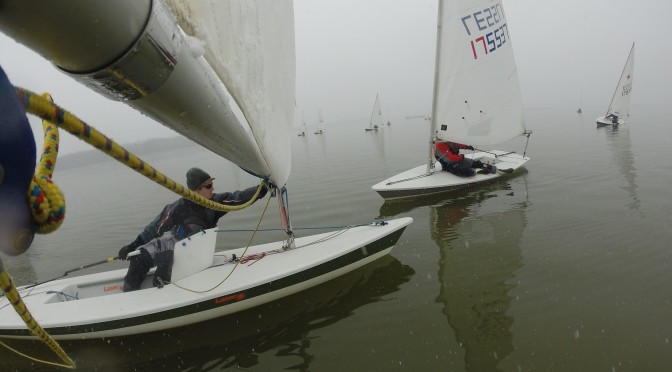Wind: NE @ ~6-10 knots
Weather: Sunny, high 40s/low 50s
Tide: heavy ebb
First of all, I would like to thank race committee for running 5 races in difficult conditions in which to set a course. They set us up farther east than normal (the windward mark was practically arms length from green channel marker on the east side of the river) to be able to get as much room as possible given the NE wind direction. Despite RC’s best efforts to set a square course, the wind did not cooperate and oscillated between the northeast and east, multiple time during each race. It took a three races for me to get used to all of the conditional factors on the course: the heavy ebbing tide, the oscillating wind direction, and the varying strength of the wind.
The Start: I came out pretty aggressive and found myself over early in the first two starts, which favored the boat. The third start favored the pin, which a few of us predicted. But my timing was off and a few boats got up to speed before I did. I won the fourth and almost the fifth starts by being patient, positioned middle-boat, but mostly by focusing on clear air and getting off the line with speed.
Upwind: Ease, hike, trim (that’s the motto, YOLO). My sincerest apologies for that terrible joke. As a smaller guy, at 150 lbs, even at the wind speeds we were seeing, I had to start thinking about “medium air” conditions. Through a couple of the whopping 8-10 kts (maybe exaggerating here) puffs I would ease my mainsail about 0.5-1 foot, hike my ass off to flatten the boat, and then trim the main back in. If the puff seemed to be sustained, I would take the slack out of the outhaul, cunningham, and vang. In some of the puffs, I actually had to depower my sail. In the first two races, I went right initially to get clear air from the fleet who were mostly middle/left (I was behind). I found that this did not work, possibly because of the deep channel and the strong current. In races 3, 4, and 5, I tried to one-tack the port lay line, which worked very well in races 4 and 5, when I reached the windward mark in 1 and 2, respectively, with a healthy lead over the rest of the fleet.
Downwind: Most of the fleet followed the boat in front, which usually led to a line forming, trying to get the starboard/inside track at the leeward mark. In every race there was a pile up at the leeward mark because of the heavy current forcing boats south. I found that even in these conditions with a moderate amount of wind, the straight line/clear air was fastest. In fact, most of the time I aimed north of the mark because of the ebbing current. Not only was I compensating for the current, but staying to the sailor’s right, cleared my air and allowed me to pass a number of boats.
Leeward Rounding: This was an important juncture in the races. As I mentioned above, the current forced pile ups. But it also left opportunities for boats rounding behind other boats to round inside. Normally, the boat in front of you has rights, as long as there was no overlap as you entered the 3 boat length circle. However, with current like we had, most boats were forced past the mark and could not round up to protect against the boat behind them without heading into irons (I fell pray to this in race 5, rounding the final mark in 1st). Two tips here: 1) for boats rounding behind, be patient, slow your boat down, if you see the boat in front of you starting his/her turn close to the mark (tight-then-wide), wait for the transom to swing around and start to round inside of your opponent. With the current, he/she will not be able to protect his water-at-the-mark. 2) for boats rounding in front of other boats, when you enter the 3 boat length circle, call for room at the mark from the boats around you (unless they had inside overlap of course).
With this amount of current it is difficult but execute a wide-then-tight rounding, shutting the door on your opponents behind you, and forcing them to round to leeward and in your dirty air.
Ultimately, this was a technical Sunday of racing because of the flukey wind directions and wind strengths. You had to really pay attention to your sail to ensure the tell-tails were flying and keep your boat flat.

